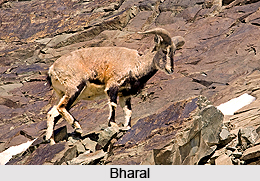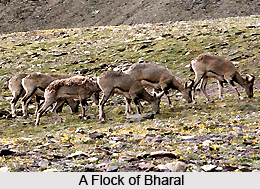 Bharal or blue sheep is essentially an animal of the Tibetian Plateau. But along the southern limit of its distribution, it has penetrated the great Himalaya around peaks like Dhaulagiri in Nepal and Nanda Devi and Trisul in India. Preferring grassy pastures near cliffs, on which it seeks safety when pursued by snow leopard and wolf, the Bharal generally remains above timber-line, from three thousand and five hundred metres upward to the limit of vegetation at five thousand and five hundred metres.
Bharal or blue sheep is essentially an animal of the Tibetian Plateau. But along the southern limit of its distribution, it has penetrated the great Himalaya around peaks like Dhaulagiri in Nepal and Nanda Devi and Trisul in India. Preferring grassy pastures near cliffs, on which it seeks safety when pursued by snow leopard and wolf, the Bharal generally remains above timber-line, from three thousand and five hundred metres upward to the limit of vegetation at five thousand and five hundred metres.
Physical Features of Bharal
A male bharal with his slate-blue pelage and black chest is a handsome creature, weighing about sixty kilograms, quite unlike the small, drab females. His body is stout, designed for climbing, and his massive horns sweep out and back in the manner of sheep, as the animal`s English name applies. In fact, when discovered in the year 1833, the bharal was placed in the genus Ovis. But it also has certain goat-like traits - a broad, flat tail, no prominent glands between the hooves, to name just two. Owing to this mixture of traits, the bharal was then placed into its own genus, Pseudois, with one species, nayaur and considered to be an aberrant goat with sheep-like affinities.
Behavioural Pattern of Bharal
Bharal are social, living in herds of about five to twenty with as many as sixty or more. Males may be solitary or in bachelor herds when not in rut. But during the rut they become active, males then striving for dominance which in turn gives them priority to estrous females. Bharal, like soldiers, carry their rank symbols with them - impressive horns, large body, and conspicuous coat - and these help males to evaluate each other`s fighting potential. Smaller animals usually accept their subordinate positions. However, sometimes a fight is necessary to settle a dominance problem. Both males may rear bolt upright on their hind legs and run at each other to bash horns with a loud clack. Goats fight like Bharal, whereas sheep rear up only partially or not at all. Behaviour patterns such as this can reveal taxonomic relationships between animals. After a fight, a low-ranking male may use a unique gesture to express friendliness: he rubs his face on the rump of the dominant animal.

Rutting of Bharal
The rut begins in late November, at the onset of winter, and lasts several weeks. Most mating is done by dominant males, those five years old and older. Such a male follows a female closely, sometimes trailed by other males who try to horn in. Competition may be fierce, the male with the largest horns winning. After a gestation period of about one hundred and sixty days, one young is born.
Diet of Bharal
Bharal are mainly grazers. For much of the year, they are placid, feeding on grass, herbs and leaves of low shrubs.



















